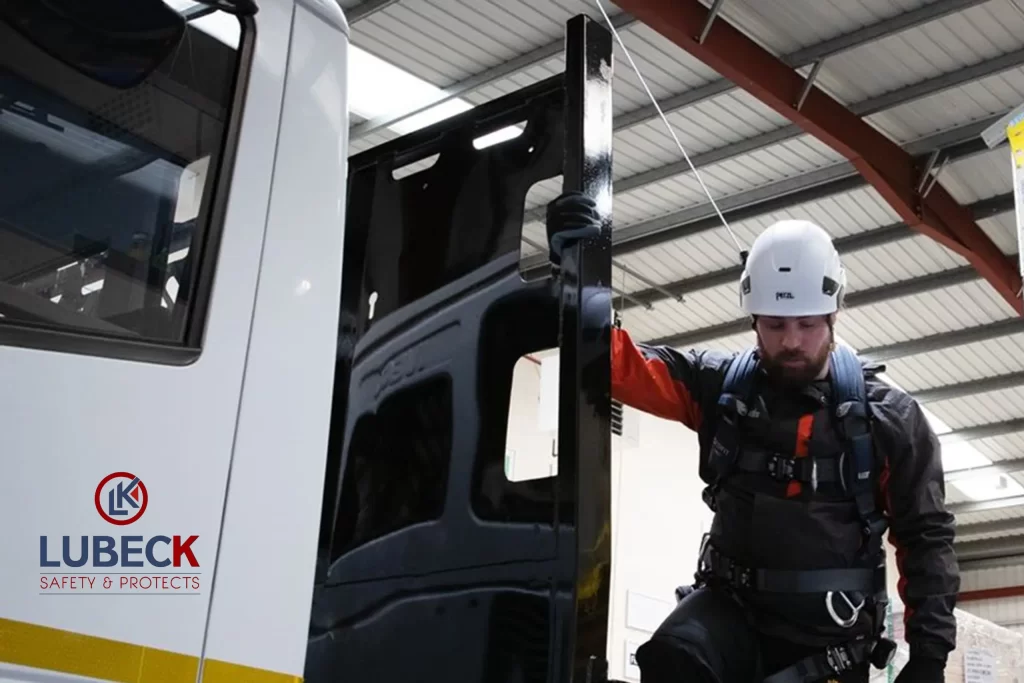- +916235962803
- info@lubecksafety.com
When working at height, ensuring worker safety is a critical priority. Overhead fall protection systems are designed to protect individuals working in elevated environments where the risk of falling from above is present. These systems provide a reliable means of preventing accidents by securing workers from potential falls, allowing them to perform their tasks with confidence and security.
Overhead fall protection refers to a safety system where the fall arrest or restraint mechanism is anchored above the worker. This system typically includes a combination of anchor points, lifelines, harnesses, and other equipment that work together to stop a fall before it results in injury. Overhead fall protection is ideal for applications such as construction sites, industrial settings, and maintenance tasks where workers are exposed to elevated risks.
Overhead Anchor Points
Anchor points are secure locations that are used to attach fall protection equipment like lifelines or lanyards. These points must be structurally sound and designed to support the weight of the worker and arrest any fall force. Overhead anchor points can be installed on ceilings, beams, or other elevated structures.
Lifelines
Lifelines are flexible ropes or cables that connect the worker’s harness to the overhead anchor point. These lifelines allow workers to move freely within a designated work area while providing continuous fall protection. Vertical and horizontal lifelines are available for various environments and tasks.
Harnesses
A fall protection harness is worn by the worker and is connected to the lifeline or lanyard. It distributes the forces of a fall across the body to reduce the risk of injury. A proper fit and adjustment are essential for maximum safety and comfort.
Self-Retracting Lifelines (SRLs)
Self-retracting lifelines are advanced fall protection devices that automatically adjust to the worker’s movements, ensuring that slack is minimized and the worker is protected at all times. SRLs retract when the worker moves closer to the anchor point and extend when the worker moves away, providing greater flexibility and safety.
Fall Arrest Systems
A fall arrest system includes a combination of equipment such as harnesses, lifelines, and deceleration devices designed to stop a fall. These systems are crucial in minimizing the distance and impact forces of a fall, thereby reducing the likelihood of serious injury.
Restraint Systems
In some applications, workers are not allowed to reach the fall hazard area, and restraint systems are used to prevent them from getting too close. These systems typically include a combination of a harness and lanyard with adjustable length to restrict movement and keep workers within a safe zone.

At Lubeck Safety, we specialize in providing top-of-the-line overhead fall protection solutions tailored to your specific needs. Our expert team works with you to design, install, and maintain fall protection systems that keep your workers safe and ensure compliance with all relevant regulations. Whether you need to outfit a new site or upgrade existing systems, we offer high-quality products and reliable support to help prevent accidents and protect your workforce.
Contact us today to learn more about our overhead fall protection solutions and how we can help you implement the right system for your workplace. Safety is our priority, and we’re here to ensure your workers are secure at every height.
For decades ,Lubeck Safety is a authorised distributor for multi national brands providing general safety equipment for industrial use, protective personal wear, head protection and safety shoes, road safety products, PPE and many more safety products and safety equipment serving Oil and gas , construction , marine and aviation industries .We invite you to take a look around our website and learn more about our products and the organization behind the brand.
For decades ,Lubeck Safety is a authorised distributor for multi national brands providing general safety equipment for industrial use, protective personal wear, head protection and safety shoes, road safety products, PPE and many more safety products and safety equipment serving Oil and gas , construction , marine and aviation industries .We invite you to take a look around our website and learn more about our products and the organization behind the brand.
©2021. Lubeck Safety. All Rights Reserved.
WhatsApp us